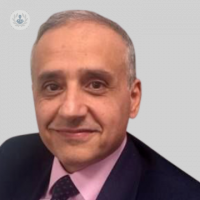Solving heart rhythm issues with pacemakers
Written by:In his latest online article, Mr Mohamed Al-Obaidi gives us his insights into pacemaker. The human heart, a marvel of natural engineering, relies on an intricate electrical conduction system to maintain its rhythm and functionality. This system includes a natural pacemaker and a network of "wiring" that enables synchronised heartbeats. However, like any complex electrical system, problems can arise over time, leading to a range of cardiac issues. In such cases, the installation of a pacemaker becomes a crucial intervention to address these "wiring" faults and restore the heart's proper rhythm and function.

The heart's electrical conduction system
The heart's electrical conduction system is essential for regulating its rhythmic contractions. This system is primarily composed of the sinoatrial (SA) node, a natural pacemaker, and a network of electrical pathways. Just like the wiring in our homes, this network can degrade or develop issues due to factors such as aging, injury, or damage. When these issues arise, the heart's rhythm can slow to a dangerous level, resulting in symptoms like dizziness, loss of consciousness, or incidental findings indicating a dangerously slow rhythm. In such cases, a pacemaker provides an effective solution to address these electrical conduction faults.
The pacemaker implantation procedure
Implanting a pacemaker is a well-established medical procedure that can significantly improve a patient's quality of life. Typically, this procedure is performed with the patient awake, although sedation is an option for those who prefer it. The process begins with the operator injecting local anaesthetic under the skin, usually in the upper left or right chest area. Although there might be some initial stinging, the local anaesthetic quickly numbs the area, reducing discomfort for the remainder of the procedure.
A small incision is then made, and a vein is carefully selected based on its size and location to accommodate the thin and flexible pacing wires. Veins naturally led back to the heart, making them ideal pathways for introducing these wires into the heart's right chambers.
Pacemakers designed to address slow heart rhythms may require one or two pacing wires, depending on the specific nature of the conduction problem. The introduction of pacing wires is typically guided by X-ray imaging to ensure precision. Once the wires are properly positioned within the heart chambers, they are rigorously tested. This testing includes pacing the heart to ensure that the wire location is optimal. If it is not, the wires can be repositioned, and the tests repeated until the most satisfactory results are achieved.
During the procedure, it's not uncommon for patients to experience sensations of an irregular, skipped, or rapid heartbeat as the wires are positioned and tested. These sensations are an integral part of the process and help ensure the wires' correct placement and function.
To maintain the stability of the pacing wires within the heart, they are secured using either small wings (tines) or a tiny screw at the tip of the wires. Stitches are used to keep the wires in place under the skin after they come out of the vein. Once secure, the pacing wires are connected to the pacemaker, which is then placed into a small pocket under the skin. The final step involves closing the incision with dissolvable stitches and medical glue, ensuring a clean and secure finish to the procedure.
Mr Mohamed Al-Obaidi is a distinguished cardiologist with over 15 years of experience. You can schedule an appointment with Mr Al-Obaidi on his Top Doctors profile.


